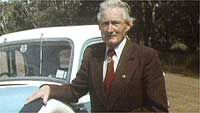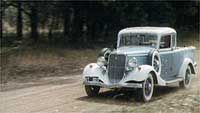Who built the first utility - where - when...
Bank managers at the time would lend money to farmers to buy a farm truck, but not a passenger car, hence the plea from one very fed up woman! It arrived on the desk of managing director Hubert French who, instead of dictating a polite dismissal, passed the letter on to sales manager Scott Inglis. Interviewed shortly before his death in 1987, Bandt recalled the moment when Westman and Inglis came to him with the letter. The brochure for the first utility "The whole thing had already started to germinate," said Bandt. Bandt began by sketching the coupé utility on a 10 metre blackboard, depicting a front view as well as side and rear elevations. When they were seen by Westman some weeks later, he told Bandt to build two prototypes.
Born out of a woman’s frustration with car designs of the day, the enclosed cab utility was initially regarded as a luxury. But the `ute’ was quickly accepted as a necessity of bush life, and won recognition around the world as the ideal farmer’s or tradesman’s vehicle. Epilogue:Lewis Thornet Bandt remained with Ford Australia until his retirement in 1976, after 48 years with the company. His career included designing long-range fuel tanks for Spitfire and Thunderbolt fighter planes in WW2, design innovations for the UK-sourced Ford Zephyr, the 1967 Australian Ford Fairlane, and the never-approved Falcon convertible, of which six were built outside Ford in 1962. Eleven years into his retirement, Bandt died on March 18, 1987, in an accident near Geelong between a sand truck and the vintage Ford ute that Bandt had rebuilt for himself (rego number UT 001, pictured above). This talented Australian is survived by the legacy of his design, which wins new friends around the world every day. Source/Bubliography; |
|
More HistoryBandt went on to manage Ford’s Advanced Design Department, being responsible for the body engineering of the XP, XT, XW and XA series Ford Falcon utilities. General Motors’ Australian subsidiary Holden also produced a Chevrolet coupe utility in 1934 but the body style did not appear on the American market until the release of the 1957 Ford Ranchero. Both the coupé utility and the similar open-topped roadster utility continued in production but the improving economy of the mid to late 1930s and the desire for improved comfort saw coupe utility sales climb at the expense of the roadster utility until, by 1939, the latter was all but a fading memory. By the 1980s in North America, the coupé utility began to fall out of favor again with the demise of the Ranchero after 1979, the Volkswagen Caddy, Dodge Rampage/Plymouth Scamp and of the Chevrolet El Camino by 1987. Subaru offered the Brat in the early 1980s, and the Baja from 2003 to 2006. General Motors considered bringing a rebadged Holden Ute to the United States in the form of the Pontiac G8 ST in 2009, but the global recession, GM's ultimate bankruptcy, and the discontinuation of the Pontiac marque caused them to cancel it. The pickup truck, on the other hand, started its life a little earlier and is defined by its separate, removable, well-type 'pickup bed'. This pickup bed does not contact the cabin part of the vehicle, while the ute bed is an integral part of the whole body. Eventually the pickup design found a natural home on the smaller truck chassis while the ute became entrenched as a passenger car derivative, although exceptions do apply. AustraliaAustralians define a "ute" as any commercial vehicle that has an open cargo carrying space, but requires only a passenger car license to drive. This includes coupé utilities, pickup trucks and traybacks (flatbed pickup trucks). An example of the broadness of this definition is that anything from a Ford F250 to a Proton Jumbuck can be called a ute. North AmericaIn North America, the major automobile and truck manufacturers built them from the 1930s to the 1980s. They were very popular in the early years with florists as a way to transport flowers and potted plants. Examples include the Studebaker Coupe Express, or the 1941 Chevrolet Coupe Pickup. A variation of the coupe pickup became the very specialized flower car that was used by funeral homes as an attendant vehicle to the hearse as part of funeral processions. Flower cars were custom-manufactured by several aftermarket coachbuilders by modifying a standard-production sedan, station wagon, or carryall (aka "suburban") in the same manner that ambulances, hearses, crummies, fire command cars, and Fire apparatus were/are manufactured. The Ford Ranchero was produced between 1957 and 1979 based on full-size, compact and intermediate automobiles by the Ford Motor Company for the North American market. Variations based on the original 1960 US Falcon for home markets in Argentina and South Africa were produced through the late 1980s. Though Ford car/truck combinations had been around since 1934 when Ford Australia's lone designer Lew Bandt penned the world's first coupe utility, thereby spawning the popularity of the so-called "ute" in that country, the Ranchero was the first postwar American vehicle of its type from the factory. The Chevrolet El Camino was produced by the Chevrolet division of General Motors from 1959 through 1960, with production resuming in 1964 and continuing through 1987. El Camino was produced in response to the success of rival Ford's Ranchero. It had a variant called the GMC Sprint and later named the GMC Caballero from 1978 to 1987. In Mexico, it was also sold as the Chevrolet Conquistador. Dodge produced the Rampage from 1982 to 1984, based on the front-wheel-drive L-body Dodge Charger. Plymouth also had a variation called the Scamp. Japanese ManufacturersA few coupé utilities have been built by Japanese manufacturers over the years, for both the domestic and other markets. Daihatsu Isuzu Mazda Subaru Suzuki Toyota Disputed coupé utilitiesThe following vehicles share qualities of both small pickups and coupe utilities, or have another reason for dispute. They are considered coupe utilities by some, and not by others. They are listed here along with a brief explanation of their respected disputes. Chevrolet SSR: the body was like a coupé utility, (albeit with a folding hardtop), and it had the performance option of the Corvette's LS2 engine (not unlike the El Camino SS and other muscle utes), but it was based on the GMT360 truck chassis, which means it is more of a sport pickup, like the Ford Lightning, Dodge Ram SRT-10, or the Chevy Xtreme. Ford Falcon utility (AU–FG): since 1999, the Falcon utility has been fitted with a cargo bed separate from the cabin, yet still retains the Falcon sedan/wagon front-end including cabin. The cargo bed was separated so that both "utility" and "cab chassis" body styles could be utilized. However, like previous models (which are officially coupé utilities), the 1999 onwards models are still derived from the Falcon sedan and wagon range. Honda Ridgeline: By the strictest definition, the Ridgeline is a coupé utility in the sense that it's essentially based on a car chassis (a unibody design that shares many parts with various Honda passenger cars, like the Accord and Acura TL), is monocoque (like many modern coupé utilities), and has an integral bed. However, it's far too large and truck-like for most people to consider it a true coupé utility. It could, perhaps, be best described as a sport utility truck or "crossover truck" instead. Subaru Baja: one could argue that the Baja is not a coupé utility simply because it's not a coupé: it has four doors rather than two. However, it otherwise fits the traditional definition of the body style. |
|
The First UteGeorge Negus Tonight - Broadcast 6.30pm on 06/02/2003 GEORGE NEGUS: Now, a new year and a new segment for our Futures program. Each week we're going to have a 'Where are they now?' segment that will focus on innovations and great ideas from the past and what's happened to them since they first appeared on the scene. For instance, speaking of cars, as we have been tonight, whatever happened to the good old Aussie ute? ADRIAN RYAN, FORD HISTORIAN: In 1933, A Gippsland farmer's wife wrote a letter to Ford, and she said, "Can you build me a vehicle that we can go to church in on Sunday without getting wet, and my husband can use it to take the pigs to market on Monday?" |
The idea of combining a car and a truck together was something that Lew Bandt came up with From the front, the ute was a very nice Ford coupe passenger car... at the back was the workhorse part of it Adrian Ryan, Ford Historian |

Ute History



 The story of the utility truck or coupé utility– the ute – began in 1932, when a letter was received by Ford Australia’s plant at Geelong, Victoria. It was written by a farmer’s wife who’d had enough of riding to church in the farm truck and arriving in saturated clothing;
The story of the utility truck or coupé utility– the ute – began in 1932, when a letter was received by Ford Australia’s plant at Geelong, Victoria. It was written by a farmer’s wife who’d had enough of riding to church in the farm truck and arriving in saturated clothing; On first sight of the prototypes, Scott Inglis authorised a startup production run of 500 vehicles. Westman asked for – and got - £10,000 for tooling, and the first coupé utilities rolled off the Geelong assembly line in 1934.
On first sight of the prototypes, Scott Inglis authorised a startup production run of 500 vehicles. Westman asked for – and got - £10,000 for tooling, and the first coupé utilities rolled off the Geelong assembly line in 1934.

